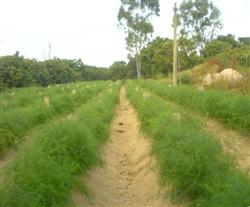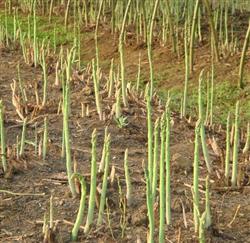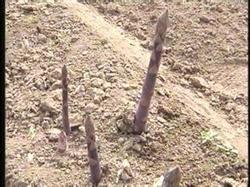Breeding and propagation methods of asparagus

1. Select good seeds: asparagus generally propagates with seeds, so it is very important to select good seeds. Asparagus seeds can be preserved for 3-5 years under good storage, but in production, the actual effective life is 2-3 years. If there is no sealed packaging, and stored in a humid environment, the germination rate of seeds will soon be lost. It usually takes more than 80 days from pollination to harvest for seeds to be fully mature before harvest. The seeds harvested in the same year can also be treated with 0-5 ℃ low temperature to break dormancy and improve germination rate. 2. Building nurseries: there are several suitable nurseries in the north of China. ① Yang bed: the Yang bed introduced here is the improved wind barrier bed. When building a sunny border, you should first build a border wall, then tie a wind barrier, and then cover the film, which can also be covered with grass grass, cover day and night, and cover the film one week before sowing to raise the ground temperature. ② small arch shed: a small arch shed is a small plastic shed with small volume and simple structure, which is bent into an arch frame with bamboo or wooden sticks and covered with plastic film. The bracket for building the shed should be tough, one every 50 to 60 centimeters, firmly inserted at both ends, and then tied firmly in series with a rope. After covering the film, it should be pressed firmly with soil all around to prevent the wind from blowing off the film. The arched shed can also be covered with grass, etc., in order to raise the ground temperature. 3. Preparation of culture soil: preparation of culture soil is the basis for cultivating strong asparagus seedlings. Nutritive soil must have good physical and chemical properties. The preparation method is as follows: fertile soil (sifted) 6 parts, organic fertilizer (stable manure, cow and horse manure, etc.) 4 parts, plus dry chicken manure or dry manure 15p 25kg, compound fertilizer 1-1.5 kg / m3, mixed evenly in the sunny bed or arch shed, 14 cm thick, flat border surface, ready for sowing. 4. Make nutrition bowls or bags: nutrition bowls or bags are cylindrical soil columns or soil bags with a height of 10cm and a diameter of 8mm. There is a seeding hole of 1 cm square in the upper center of the bowl. Nutrition bowls are generally made from bowl-making vessels. The nutrient soil used should be carefully prepared, the method is: stable manure cow and horse manure: fertilizer soil = 3:7, mixed sieve, add water to adjust humidity, dry and wet standard to hand into a ball, falling to the ground scattered for degrees. The nutrition bag is made of waste newspaper into a cylindrical paper tube the same size as the nutrition bowl, which is filled with prepared nutrient soil. 5. Seed treatment methods: the seed coat of asparagus is thick and hard, and it takes a long time to absorb enough water, so the seeds must be treated before sowing in order to improve the germination rate and germination energy of the seeds. The seeds are generally treated in the following ways: ① for 3 days (put 2mi 3cm on the shed cloth, turn 2mi 3 times a day for 2-3 days) ② rinse to remove impurities, shrunken, and moth-eaten seeds. The sand is hidden until the planting time before winter. Choose high dryness before winter, dig a deep pit of about 50 centimeters toward the sun, and then store a layer of sand. The sand should have a certain humidity, and the buried depth of the seeds should not be less than 20 centimeters. After the beginning of spring, the seeds can be sifted out and the seeds can be inserted. Because the seeds absorb enough water, so the seedlings emerge quickly. Soak the seeds in warm water. Seeds that have not been stored in sand should be soaked in warm water of 45 ℃ and 50 mol before sowing. After the water temperature drops to room temperature, soak the seeds for 3 days, change the water 3 times a day, and then remove the seeds and put them in a box. 6. Accelerating germination: wrap the soaked seeds with clean gauze and put them under the condition of 25 ℃ and 30 minutes to promote germination. Rinse the seeds with warm water twice a day to remove the secretions from the seeds to prevent mildew and rot. When 10% of the seeds are broken and 15% of the seeds are exposed, sowing can be carried out. If you cannot sow immediately, the seeds should be spread out in a cool and ventilated place to prevent the buds from growing too long and be knocked off when sowing.
- Prev

Key points of asparagus seedling raising technique
The main points of cultivation techniques of asparagus are introduced as follows: first, the selection of varieties is different from other vegetables. Asparagus is a perennial plant, and it can be harvested continuously for 15 years at one time. Therefore, the first generation hybrid varieties with disease and insect resistance, strong stress resistance, short dormancy period, good commodity, high quality and high yield should be selected. Second, education.
- Next

Cultivation Techniques of Asparagus in Summer
1. Asparagus blight 1. Symptoms. This disease is also called blight, which is a soil-borne disease. At first, individual plants in the field turned yellow and wilted. After the disease expanded, the whole plant died, the tender stem was infected, the pseudo-leaves and stems turned brown or split longitudinally. The underground stems and roots of the diseased plants could show brown disease spots. In the later stage, the diseased parts rotted, producing white to pink mold...
Related
- Where is it suitable to grow horseradish in China? it is expected to see the middle altitude horseradish in Alishan.
- How to prevent tomato virus disease reasonably? (Control methods included)
- Many people like to plant towel gourd on the balcony. What are the main points of this method and management?
- What crops can chili peppers be mixed with?
- Fertilization techniques and matters needing attention in Tomato
- What are the grafting techniques for peach seedlings in spring?
- Harm and control methods of root swelling disease of Chinese cabbage
- What are the pests of sweet potatoes? How to prevent and cure it?
- Symptoms, causes and Control methods of navel Rot in Tomato
- The cause of "Cucumber rotten bibcock" in Farmers' planting Cucumber and its Control Plan

